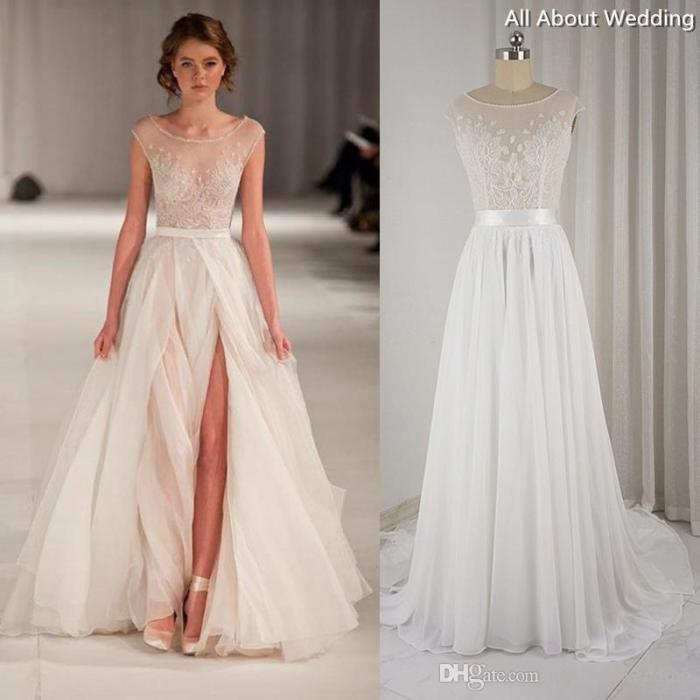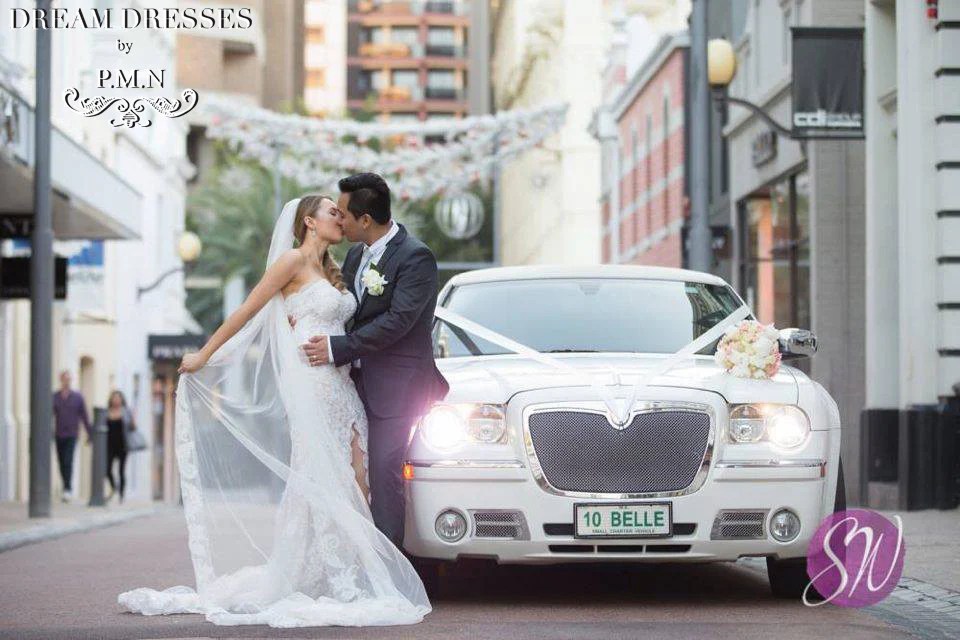Split Front Wedding Dresses A Style Guide
Understanding Split Front Wedding Dresses
Split front wedding dresses offer a unique blend of elegance and modernity, allowing brides to showcase their personality and style. This design element adds a touch of daring and sophistication, creating a captivating silhouette. This article delves into the various aspects of split front wedding dresses, from their defining characteristics to styling and care.
Defining “Split Front Wedding Dress”
A split front wedding dress is characterized by a strategically placed slit or opening in the front of the skirt, revealing a portion of the leg. This design detail can range from a subtle, high-thigh slit to a more dramatic, floor-length opening. The placement and length of the split significantly influence the overall look and feel of the dress. Various styles exist, offering diverse options for brides.
Styles and Split Lengths
Split front wedding dresses come in a variety of styles. These include A-line gowns with a subtle front slit, mermaid dresses featuring a high, dramatic split, and ball gowns incorporating a less pronounced, modest slit. The length of the split can also vary considerably, ranging from a short, barely-there slit to a long, leg-revealing opening that extends almost to the hem.
The height of the split can also be adjusted to create a range of looks, from conservative to very daring. The placement significantly affects the overall aesthetic. A high split tends to create a more modern and bold look, whereas a lower split offers a more subtle and sophisticated appearance.
Impact of Split Placement on Silhouette
The placement of the split dramatically impacts the overall silhouette. A high slit elongates the legs and creates a more dramatic and modern look, while a lower slit offers a more subtle and classic feel. A centrally placed split emphasizes symmetry, whereas an asymmetrical split adds a touch of unexpected flair. The choice should align with the bride’s personal style and comfort level.
Comparison with Other Styles
Compared to traditional wedding dresses, split front dresses offer a more modern and contemporary aesthetic. Unlike the classic ball gown or sheath dress, split front dresses inject a sense of playful sophistication. They offer a contrast to the formality of a traditional wedding dress, providing a unique and memorable look.
Fabrics and Materials
The choice of fabric significantly impacts the drape, movement, and overall aesthetic of a split front wedding dress. Different fabrics lend themselves to different split styles and overall looks. Careful consideration of fabric properties is essential for achieving the desired effect.
Fabric Suitability and Drape
Silks, chiffons, and satins drape beautifully, accentuating the movement of the split. Lace adds texture and elegance, while tulle provides a lighter, more ethereal feel. Heavier fabrics like brocade might be less suitable for dramatic splits, potentially hindering movement. The fabric’s weight and texture affect how the split falls and moves.
Fabric Texture and Overall Look
The texture of the fabric contributes significantly to the overall look of the dress. A smooth, flowing silk creates a sleek and sophisticated look, while a textured lace adds a touch of romantic whimsy. The interplay of textures, such as combining lace with a silk lining, can create depth and visual interest.
Fabric Comparison Table
| Fabric Type | Drape | Texture | Suitability for Split |
|---|---|---|---|
| Silk | Excellent | Smooth | Highly Suitable |
| Lace | Good | Textured | Suitable |
| Tulle | Moderate | Lightweight | Suitable for less dramatic splits |
| Chiffon | Excellent | Lightweight, sheer | Highly Suitable |
Styling and Accessories
Styling a split front wedding dress involves thoughtful consideration of the venue, accessories, and overall aesthetic. The versatility of this style allows for a range of looks, from bohemian chic to classic elegance.
Styling for Different Venues
A beach wedding might call for a flowing chiffon gown with a high slit, paired with simple jewelry and sandals. A ballroom wedding could feature a more structured silk gown with a subtle split, complemented by elegant heels and statement jewelry. A garden wedding might suit a lace gown with a moderate split, adorned with delicate floral accessories.
Suitable Accessories
Accessories play a crucial role in completing the look. Heels, particularly those with straps or ankle details, complement the leg revealed by the split. Delicate jewelry, such as a simple necklace or earrings, prevents overwhelming the design. Veils can add a touch of traditional elegance or be omitted for a more modern feel.
Creating Different Looks with Accessories
The same split front dress can be styled in various ways using different accessories. A minimalist look can be achieved with simple jewelry and neutral-colored heels, while a bolder look can be created with statement jewelry and brightly colored shoes. A change of veil or headpiece can also significantly alter the overall aesthetic.
Contrasting Accessory Choices
Contrasting accessory choices highlight the versatility of the dress. Pairing a classic gown with modern accessories, or vice-versa, creates a unique and unexpected look. Experimenting with different styles of shoes, jewelry, and veils allows the bride to express her personal style.
Body Types and Fit

Source: etsystatic.com
Split front wedding dresses can flatter various body types when chosen and fitted correctly. Understanding the impact of the split’s placement and style on different body shapes is crucial for finding the perfect dress.
Flattering Different Body Types
A high slit can elongate the legs, making it ideal for petite brides. A moderate slit can balance proportions for brides with curvier figures. The style of the dress itself, such as an A-line or mermaid silhouette, further complements different body shapes.
Importance of Proper Fit and Alterations
Proper fit is essential for a flattering and comfortable look. Alterations are often necessary to ensure the dress drapes correctly and accentuates the bride’s figure. A skilled seamstress can adjust the split’s height and placement to achieve the perfect fit.
Considerations for Height and Body Shape
Taller brides might opt for a longer, more dramatic split, while shorter brides might prefer a shorter, more subtle slit. Curvier brides might consider a dress with a strategically placed split that complements their figure.
Choosing the Right Split Style
Brides with an hourglass figure might choose a dress with a moderate split that accentuates their waist. Brides with a pear shape might opt for a dress that balances their proportions with a strategically placed split. Brides with a rectangle shape might choose a dress that adds curves with a well-placed split.
Design Elements and Details: Split Front Wedding Dress

Source: emasscraft.org
The design elements of a split front wedding dress contribute significantly to its overall aesthetic. From neckline styles to embellishments, these details can enhance the dress’s unique charm.
Neckline Styles
Various neckline styles pair well with split front dresses. A sweetheart neckline adds romance, while a V-neck elongates the torso. A halter neck provides a modern touch, and a bateau neck offers a classic and elegant feel. The choice depends on personal preference and the overall style of the dress.
Embellishments
Embellishments such as beading, embroidery, or appliqués can enhance the detail and texture of the dress. These details can be concentrated around the neckline, waist, or along the edges of the split for added visual interest.
Unique Design Details
Asymmetrical splits, layered fabrics, or unique detailing at the hemline add a distinctive touch. These details showcase creativity and personalize the dress. Consideration of these elements can result in a truly unique and memorable wedding dress.
Visual Representation of a Split-Front Dress
Imagine a flowing A-line gown crafted from ivory silk chiffon. The neckline is a delicate V-neck, accentuating the bride’s collarbone. Delicate beading adorns the bodice, adding subtle sparkle. A thigh-high slit, positioned slightly off-center, adds a touch of modern flair. The skirt flows gracefully, creating a romantic and ethereal silhouette.
Care and Maintenance
Proper care and maintenance are crucial for preserving the condition of a split front wedding dress. Understanding the specific challenges associated with this style is essential for ensuring its longevity.
Cleaning and Storage Methods
Professional dry cleaning is recommended to preserve the fabric and prevent damage. The dress should be stored in a breathable garment bag in a cool, dry place, away from direct sunlight and moisture. Avoid hanging the dress by the straps, which can stretch or damage the fabric.
Challenges in Maintaining a Split Front Dress
The split area is particularly susceptible to snags or tears. Extra care should be taken when handling the dress, and avoid dragging it on the ground. Regular inspections can help identify any potential issues early on.
Split front wedding dresses offer a modern twist on traditional bridal wear, allowing for a comfortable and stylish look. For the reception, a change of attire might be considered, and exploring options like those detailed in this guide on reception dress for indian wedding could provide inspiration. Returning to the split front style, consider pairing it with bold accessories to complement the unique design and create a memorable bridal ensemble.
Preventing Damage to the Split Area, Split front wedding dress
Avoid wearing the dress in areas with rough surfaces or potential hazards. Use a fabric protector spray to help prevent stains and damage. Handle the dress gently to avoid pulling or stretching the fabric around the split.
Care Checklist

Source: shopify.com
- Professional dry cleaning after the wedding
- Storage in a breathable garment bag
- Avoid direct sunlight and moisture
- Regular inspection for damage
- Careful handling to avoid snags or tears
Clarifying Questions
What is the best way to hem a split front wedding dress?
It’s crucial to take your split front wedding dress to a professional seamstress for hemming. The split requires precise alterations to maintain its intended drape and prevent unwanted fraying or damage.
Can I wear a split front wedding dress if I’m petite?
Absolutely! A well-chosen split front dress can flatter petite figures. Opt for a dress with a shorter split to avoid overwhelming your frame. Consider a dress with a defined waist to create the illusion of longer legs.
How do I choose the right undergarments for a split front wedding dress?
Select seamless undergarments to avoid visible lines under the dress. Consider a nude-colored shapewear option to smooth your silhouette and provide support. Avoid anything bulky or that might show through the fabric.
Are split front wedding dresses appropriate for all wedding venues?
While versatile, the appropriateness depends on the style and length of the split and the formality of the venue. A subtle split works well almost anywhere. However, very high or dramatic splits might be less suitable for very formal or religious ceremonies.



















